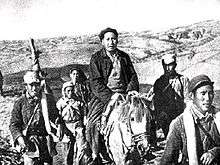Battle of Yan'an
| Battle of Yan'an | |||||||
|---|---|---|---|---|---|---|---|
| Part of Chinese Civil War | |||||||
| |||||||
| Belligerents | |||||||
|
National Revolutionary Army |
People's Liberation Army | ||||||
| Commanders and leaders | |||||||
|
|
| ||||||
| Strength | |||||||
| 8,100 | 3,700 | ||||||
| Casualties and losses | |||||||
| 1,500 | ? | ||||||
After World War II, Hu Zongnan battled the Communist Party of China and in the early stage of the struggle, was once successful in the Battle of Yan'an taking Yan'an, the capital of the communist base in Shaanxi.
Yan'an had served as the capital of Red China from the end of the Long March in 1935, through World War II, until its capture in 1947. The earlier KMT campaigns in the 1930s had been a failure.
There was only token Red resistance, as most Reds had already fled in advance in a strategic withdrawal to lure Hu to the Northwest.
With the outbreak of full-scale civil war between Communists and Nationalists in early 1947, Xi Zhongxun remained in northwestern China to coordinate the protection and then recapture of the Yan'an Soviet Area.[2] As political commissar, Xi and commander Zhang Zongxun defeated Nationalists west of Yan'an at the Battle of Xihuachi in March 1947.[2] After Yan'an fell to Hu Zongnan on March 19, 1947, Xi worked on the staff of Peng Dehuai in the battles to retake Yan'an and capture northwest China.
Many high-level Communist leaders were forced to flee their lost Capital, and Chiang Kai-shek declared final victory.
KMT forces were only able to hold Yanan for about a week, and PLA forces rapidly recaptured it. The KMT commitment to conventional-style warfare with a focus on capturing fixed political capitals as objectives, immobilized a large KMT army in the useless Northwest front, making them impotent for the more important mobile campaigns in the East.
In protracted guerrilla warfare, traditional military objectives such as capturing the enemy's capital is no longer decisive.
The famous picture of Mao, often erroneously attributed to the Long March, is actually of Mao leading the march to Northern Shaanxi in 1947.

See also
- List of battles of the Chinese Civil War
- National Revolutionary Army
- History of the People's Liberation Army
- Chinese Civil War